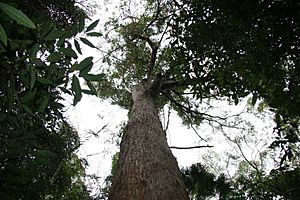Tallowwood facts for kids
Quick facts for kids Tallowwood |
|
|---|---|
 |
|
| Scientific classification | |
| Genus: |
Eucalyptus
|
| Species: |
microcorys
|
The Tallowwood (scientific name: Eucalyptus microcorys) is a tall tree found only in eastern Australia. It gets its name "tallowwood" because its wood feels a bit greasy, like tallow (animal fat). This tree has rough, stringy bark on its trunk and branches. Its leaves are shaped like a spear or an egg. When it blooms, it has white or lemon-yellow flowers. Later, it grows small, cone-shaped fruits. You can find Tallowwood trees growing in forests along the coast of Queensland and New South Wales.
Contents
What Does Tallowwood Look Like?
The Tallowwood tree usually grows very tall, reaching about 40 to 60 meters (130 to 200 feet) high. Some can even grow up to 70 meters (230 feet)! At the base of the tree, it has a special woody swelling called a lignotuber. This helps the tree regrow if it gets damaged, for example, by a bushfire.
Bark and Leaves
- Bark: The Tallowwood has rough, stringy bark that is brownish in color. It covers both the main trunk and the branches.
- Young Leaves: When the tree is young, or when new shoots grow from the base (called coppice regrowth), the leaves are egg-shaped. They are lighter in color on the underside. These leaves are about 40 to 110 millimeters (1.5 to 4 inches) long and 15 to 50 millimeters (0.6 to 2 inches) wide.
- Adult Leaves: The leaves on older trees are shiny green and also lighter underneath. They are shaped like a spear or an egg, or sometimes slightly curved. They measure about 60 to 150 millimeters (2.3 to 6 inches) long and 15 to 35 millimeters (0.6 to 1.4 inches) wide. Each leaf has a short stem called a petiole, which is about 10 to 15 millimeters (0.4 to 0.6 inches) long. If you look closely, you'll see that the leaf veins are easy to spot and spread out at an angle greater than 45 degrees from the main middle vein.
Flowers and Fruit
- Flower Buds: The flower buds usually grow in groups of seven or nine at the ends of the branches. These groups are on a main stalk called a peduncle, which is about 4 to 18 millimeters (0.15 to 0.7 inches) long. Each individual bud has its own small stem called a pedicel, about 4 to 8 millimeters (0.15 to 0.3 inches) long.
- Mature Buds: When the buds are ready to open, they are shaped like a club and are yellow. They are about 3 to 5 millimeters (0.1 to 0.2 inches) long and 3 millimeters wide. The top part of the bud, which covers the flower, is rounded. This top part is called an operculum.
- Flowering Time: Tallowwood trees bloom between August and January.
- Flowers: The flowers are white to lemon-yellow.
- Fruit: After flowering, the tree produces woody, cone-shaped fruits. These fruits are a type of dry seed pod called a capsule. They are about 5 to 9 millimeters (0.2 to 0.35 inches) long and 5 to 6 millimeters (0.2 to 0.24 inches) wide. The parts that open to release the seeds are located near the rim of the fruit.
How Tallowwood Got Its Name
The Tallowwood tree was first officially described in 1860 by a scientist named Ferdinand von Mueller. He wrote about it in a book called Fragmenta Phytographiae Australiae. The specimens he studied were collected by Hermann Beckler near the Hastings and Macleay Rivers in Australia.
The scientific name microcorys comes from two ancient Greek words:
- micro- means "small"
- corys means "helmet"
So, microcorys means "small helmet," which likely refers to the shape of the flower bud's cap (operculum).
Where Does Tallowwood Grow?
Tallowwood trees mostly grow in tall, open forests. They prefer rich, fertile soil found on slopes, ridges, and in valleys. You can find them from Fraser Island in Queensland, all the way south to Cooranbong in New South Wales. They also grow inland as far as Toowoomba.
Gallery






